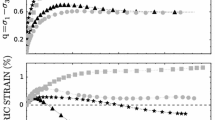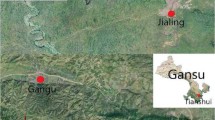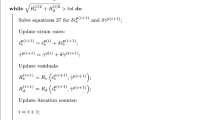Abstract
This paper summarizes the results of a theoretical and experimental program at Sandia National Laboratories aimed at identifying and modeling key physical features of rocks and rock-like materials at the laboratory scale over a broad range of strain rates. The mathematical development of a constitutive model is discussed and model predictions versus experimental data are given for a suite of laboratory tests. Concurrent pore collapse and cracking at the microscale are seen as competitive micromechanisms that give rise to the well-known macroscale phenomenon of a transition from volumetric compaction to dilatation under quasistatic triaxial compression. For high-rate loading, this competition between pore collapse and microcracking also seems to account for recently identified differences in strain-rate sensitivity between uniaxial-strain “plate slap” data compared to uniaxial-stress Kolsky bar data. A description is given of how this work supports ongoing efforts to develop a predictive capability in simulating deformation and failure of natural geological materials, including those that contain structural features such as joints and other spatial heterogeneities.















Similar content being viewed by others
References
Arguello JG, Fossum AF, Zeuch DH, Ewsuk KG (2001) Continuum-based FEM modeling of alumina powder compaction. KONA 19:166–177
Duvaut G, Lions JL (1972) Les inequations en mecanique et en physique. Dunod, Paris
Fossum AF, Brannon RM (2004) The Sandia GeoModel: theory and user’s guide. Technical report No SAND2004-3226 UC-405, Sandia National Laboratories, Albuquerque
Fossum AF, Brannon RM (2004) Unified compaction/dilatation, strain-rate sensitive, constitutive model for rock mechanics structural analysis applications. In: Proceedings of the 6th North America rock mechanics symposium: rock mechanics across borders and disciplines, Houston, in CD-ROM
Fossum AF, Fredrich JT (2000) Cap plasticity models and compactive and dilatant pre-failure deformation. In: Girard J, Liebman M, Breeds C, Doe T (eds) Pacific rocks 2000: rock around the rim. A.A. Balkema, Amsterdam, pp 1169–1176
Fossum AF, Senseny PE, Pfeifle TW, Mellegard KD (1994) Experimental determination of probability distributions for parameters of a Salem limestone cap plasticity model. Mech Mat 21:119–137
Foster CD, Regueiro RA, Fossum AF, Borja RI (2005) Implicit numerical integration of a three-invariant, isotropic/kinematic hardening cap plasticity model for geomaterials. Comp Meth Appl Mech Eng 194:5109–5138
Frew DJ, Forrestal MJ, Chen W (2001) A split Hopkinson pressure bar technique to determine compressive stress–strain data for rock materials. Exp Mech 41:40–46
Frew DJ, Forrestal MJ, Akers SA (2006) A triaxial Hopkinson pressure bar technique to determine compressive stress–strain data for rock materials. (in press)
Gudehus G (1973) Elastoplastische stoffgleichungen fur Trockenen sand. Ingenieur Arch 42:151–169
Kolsky H (1949) An Investigation of the mechanical properties of materials at very high rates of loading. Proc R Soc Lond B 62:676–700
Kolsky H (1963) Stress waves in solids. Dover, New York
Larson DB, Anderson GD (1979) Plane shock wave studies of porous geologic media. J Geophys Res 84:4592–4600
Lee MY, Fossum AF, Costin LS, Bronowski D (2002) Frozen soil material testing and constitutive modeling. Technical report No SAND2002-0524, Sandia National Laboratories, Albuquerque
Pelessone D (1989) A modified formulation of the cap model. Technical report No GA-C19579, Gulf Atomics
Schwer LE, Murry YD (1994) A three-invariant smooth cap model with mixed hardening. Int J Num Anal Meth Geomech 18:657–688
Senseny PE, Fossum AF, Pfeifle TW (1983) Non-associative constitutive laws for low porosity rocks. Int J Num Anal Meth Geomech 7:101–115
Warren TL, Fossum AF, Frew DJ (2004) Penetration into low strength (23 MPa) concrete: target characterization and simulations. Int J Impact Eng 30:477–503
Willam KG, Warnke EP (1975) Constitutive model for the triaxial behavior of concrete. In: Concrete structures subjected to triaxial stresses. ISMES, Bergamo
Acknowledgements
The authors gratefully acknowledge the support of the Advanced Simulation and Computing Physics and Engineering Models Program entitled, “Enhancement Geomechanics Modeling,” led by John Pott of Sandia National Laboratories. Sandia National Laboratories is a multiprogram laboratory operated by Sandia Corporation, a Lockheed Martin Company, for the United States Department of Energy under Contract DE-A04-94AL85000.
Author information
Authors and Affiliations
Corresponding author
Rights and permissions
About this article
Cite this article
Fossum, A.F., Brannon, R.M. On a viscoplastic model for rocks with mechanism-dependent characteristic times. Acta Geotech. 1, 89–106 (2006). https://doi.org/10.1007/s11440-006-0010-z
Received:
Accepted:
Published:
Issue Date:
DOI: https://doi.org/10.1007/s11440-006-0010-z




